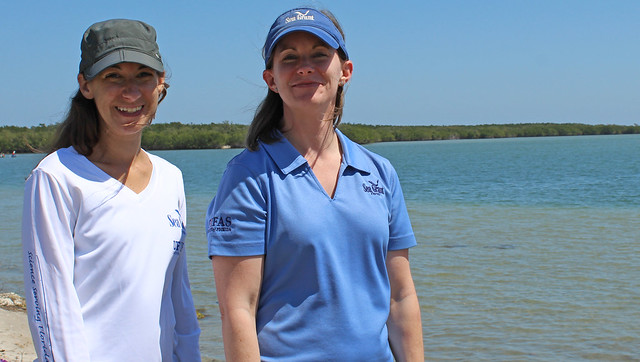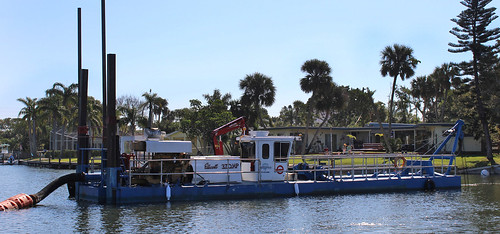
Lisa Krimsky (left) and Holly Abeels provide objective science-based information on water issues that businesses and residents can use for planning and decision making. Florida Sea Grant photo
“We had to stop our business for several days. Trust me when I say that we suffered from the smell,” said Mary Radabaugh, manager of Central Marine in Stuart.
Radabaugh is referring to the odors from thick algae blooms that carpeted areas of the Indian River Lagoon in the summer of 2016.
The blooms, caused by excessive fertilizer runoff, domestic wastewater, muck and other sources of nutrient pollution, suffocated plant and animal life, resulting in extensive seagrass die-offs and fish kills. To date, 60 percent of the lagoon’s seagrass has died.
“Nobody wanted to do anything in the water. During our busiest months last year, our water-dependent business was down 90 percent,” said David Lane, owner and operator of A1A Outdoors, an outdoor adventure provider also located on the Indian River Lagoon, but nearly 100 miles north in Cape Canaveral.
“From an economic standpoint, we need to be competitive,” Lane said. “And to be competitive we need clean water.”
Earlier this year, Radabaugh and Lane addressed a room of scientists gathered for an annual Indian River Lagoon science symposium. Their presentations, organized in part by Florida Sea Grant water resources specialist Lisa Krimsky in partnership with the Martin County Engineering Department and UF/IFAS Extension in St. Lucie County, brought real-life experiences to the front of the science agenda.
In all, four small business owners and residents, each with a close working and living relationship with the lagoon, shared from a non-science standpoint how the nutrient-fueled algae blooms impacted their lives.
The forum typifies how Sea Grant agents with UF/IFAS Extension relay the information needs and problems of residents in their community to researchers, especially in areas of peril like the Indian river Lagoon.
“We had a great opportunity to expand the mostly science focus of the program to include a citizen component,” said Krimsky, who is one of five newly hired water resource regional specialized agents with UF/IFAS Extension.
“Our panel’s goal was to have a variety of stakeholders sharing real perspectives, failures and successes regarding water quality and the 2016 algal blooms throughout the Indian River Lagoon, with the hopes of giving a human face to the problem,” Krimsky said.

Removing muck from the lagoon bottom is key to improving water quality. This barge-mounted dredge pumps muck from residential canals to a manmade island for drying and disposal. Florida Sea Grant photo
The Indian River Lagoon is a major economic engine for many communities along Florida’s eastern coast. According to a 2016 report by the Indian River Lagoon National Estuary Program, the Lagoon provides $2.6 billion in annual income to the state through water-related industries.
One of Krimsky’s objectives will be to collaborate with other Sea Grant agents in the Indian River Lagoon area, providing credible, objective information that businesses and residents can use in their planning and decision-making.
Last November, the voters of Brevard County, a populous stretch of Florida that straddles more than 70 percent of the Lagoon, approved a 1/2 cent sales tax to fund the 10-year Save Our Lagoon initiative. Its goal is to improve water quality in the lagoon by reducing pollution inputs, removing detrimental sediments, and restoring marine life habitat.
Before residents headed to the polls, Krimsky and Holly Abeels, Florida Sea Grant agent with UF/IFAS Extension in Brevard County, developed a set of four science-based fact sheets that explained aspects of the project plan including muck removal, fertilizer management, septic systems and living shorelines.
The publication series helped explain the science behind the plan to a lay audience so residents could make an informed vote. The plan, which county officials say is expected to provide $2 billion in economic gain by increasing tourism, property values and commercial fishing opportunities, passed by 62.3 percent.
“We decided that creating these one-page fact sheets was one way that we could help break down information in the Save Our Lagoon plan for the public. It was our hope that the fact sheets would answer some of the most common questions about it,” Abeels said.
Krimsky and Abeels say they will continue to provide outreach on the latest science and information as lagoon-related projects continue.
“We will be focusing on developing and expanding new and existing programs that address local watershed inputs,” Krimsky said.
“We want to provide residents and businesses the best tools for minimizing their nutrient footprint today so that we can move away from restoration and work toward preservation.”
Presentations from the Indian River Lagoon Symposium can be viewed here: Symposium recording
Read the Save Our Indian River Lagoon fact sheet series to learn more:
- Muck Removal in the Save Our Indian River Lagoon Project Plan
- Fertilizer Management in the Save Our Indian River Lagoon Project Plan
- Septic Systems in the Save our Indian River Lagoon Project Plan
- Living Shorelines and Restoration in the Save Our Indian River Lagoon Project Plan



